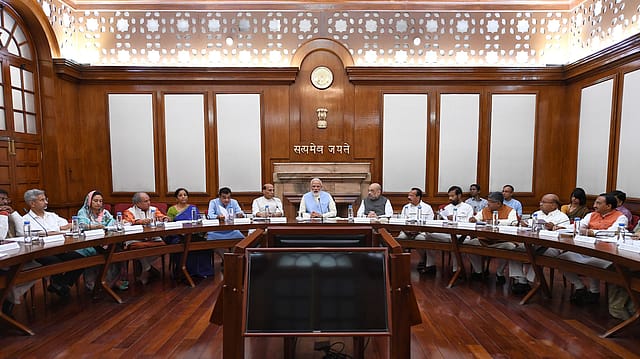Modi 2.0: Guardians of the economy
ADVERTISEMENT

It is really time to take the bull by the horn, bite the bullet and announce some bold structural reforms to get the slowing economy moving again. It calls for land and labour reforms, creating better enabling business environment for domestic and foreign players, better infrastructure, developing skilled workforce etc for a new India led by Prime Minister Narendra Modi.
And it is Modi's A-team led by India's first women finance minister Nirmala Sitharaman, road transport and small and medium and micro industries minister Nitin Gadkari, railways and commerce and industry minister Piyush Goyal, and petroleum and steel minister Dharmendra Pradhan, who will be expected to stand and deliver.
Fortunately, most of them not only have some prior experience but are also aware of the challenges that the economy faces as the Modi government as it begins its second innings. For 59-year-old Nirmala Sitharaman, the new portfolio is not really new, because she has already served as a minister of state with independent charge for corporate affairs as well as minister of commerce and industry for three years. Moreover, with a post graduate degree in economics from Jawaharlal Nehru University, she has the relevant qualifications and expertise to pull the economy from its current morass.
January 2026
Netflix, which has been in India for a decade, has successfully struck a balance between high-class premium content and pricing that attracts a range of customers. Find out how the U.S. streaming giant evolved in India, plus an exclusive interview with CEO Ted Sarandos. Also read about the Best Investments for 2026, and how rising growth and easing inflation will come in handy for finance minister Nirmala Sitharaman as she prepares Budget 2026.
However, the challenges for her are many and complex. The non-banking financial institutions are suffering from a liquidity crisis, the farm sector is in acute distress and the small scale industries are in pain especially after the government's demonetisation drive, consumption is falling with many sectors reporting poor growth or even degrowth and companies are being forced to cut down on their investment plans and workforce, amidst rampant unemployment all around. She has a huge task ahead of her.
For 54-year-old Piyush Goyal, who has already proved himself with many firsts in the railway ministry, the real challenge will be on the trade front. Exports and imports have slowed down considerably with most countries adopting protectionist policies, especially the U.S., with its "Make in America" slogan. Goyal, a former investment banker, also has to ensure that India faces minimum collateral damage as a result of the ongoing U.S.-China trade war and its adverse impact on global trade. Entering into regional trade pacts could help Indian exporters as it is about making Indian goods globally competitive.
Thankfully, the Indian railways seems to be in a much better shape. Its finances and the quality of the services have improved, and many new initiatives have been launched. During his tenure, Goyal announced the launch of the first bullet train between Mumbai and Gujarat, delivered the first high-speed engine-less train, Vande Mataram Express, and saw the least number of train accidents in his tenure.
For the 62-year-old Nagpur MP, Nitin Gadkari, the medium small and micro industries players, would be expecting him to create the same kind of magic that he conjured up for roadways and highways sector, making him one of the most successful ministers. The MSME sector is already suffering from lack of credit flow from the banking sector and now also from the NBFCs, post the IL&FS fiasco, inadequate skilled workforce. little investments in R&D and regulatory bottlenecks . Getting this sector, which contributes nearly 40% to India's exports and 35% to the country's GDP, back on track, is important if India hopes to achieve 8% to 9% growth and generate the necessary employment.
Meanwhile, Gadkari has already outlined his plans for highways, which includes building a network of "world-class expressways" across the length and breadth of the country. Another challenge for him will be to get the electric vehicle infrastructure in place like setting up charging stations etc as electric vehicles increasingly become a reality on Indian roads.
Petroleum and steel minister Dharmendra Pradhan might not find the going as smooth in his second innings as it was in his first. His first innings started on a perfect note with crude prices touching a record low and staying low for most of his term. It also helped the government reaping a bonanza in terms of tax collections. But with the U.S. imposing major trade sanction on Iran a major exporter of crude to India and Venezuela witnessing a sharp drop in its oil production, at a time when prices are already high could pose a serious challenge for the government. How 49-year-old Pradhan uses his negotiating skills to ensure a continuous flow of crude supply in these times, will be interesting to watch. It will also be his responsibility to ensure that the" boom and bust cycle" a regular feature of the Indian economy with low and high oil prices does not happen again.
Secondly, reviving the steel sector too will occupy a part of his time. The slowdown in the construction industry, the sharp fall in automobile production among other things, have adversely impacted the steel sector, not to forget dumping of steel by China in India as a fallout of the U.S.-China trade war.
The challenges are well known and so are the solutions. But it will call for a deep understanding of the ills of the economy, strong political will to resolve them, deft negotiation skills and fast implementation of policies. Will the ministers be up to their tasks will be clear in the next few months time.
